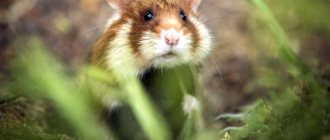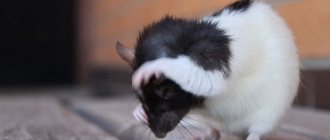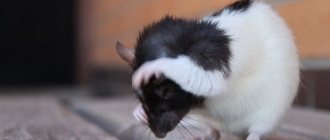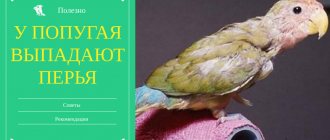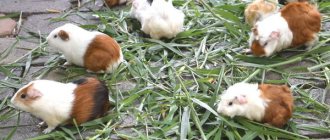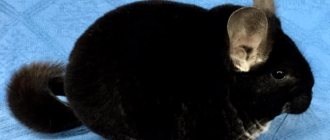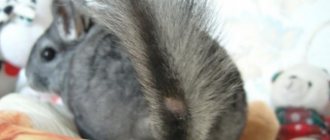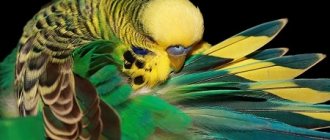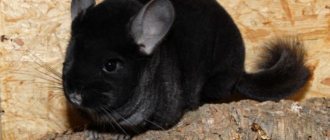- home
- Chinchilla
- Health
03/25/2019 If you periodically notice your chinchilla itching, you should not immediately sound the alarm. All animals do this sometimes, but if the animal bites itself and itches constantly, examine it. The condition of the rodent's skin determines whether it needs the help of a veterinarian, or whether a minor correction of care is sufficient.
If the chinchilla does not lose hair, it has clear skin without redness, blisters or peeling; it may itch due to the dry air in the room. In this case, limit bathing in the sand to once a week or use a humidifier. Otherwise, you need to show the animal to a specialist and carry out the treatment recommended by him.
Intestinal parasites
Infection with worms is quite common and is epidemic in nature. A small infection may be invisible to the owner and the animal may not show signs of concern. However, if there are a lot of parasites, this leads to noticeable weight loss, frequent digestive problems, and parasite eggs can be found in feces. It is recommended to treat with Furazolidone. One tablet is crushed and added to the drinking bowl.
The course of treatment is ten days. At the same time, the animals must be given Nemozol through a syringe - 15 ml per kilogram of live weight. The medicine is given twice a day for a week and repeated after ten days.
During treatment, careful cleaning and treatment of the cage is necessary.
Do I need to rinse my eyes?
Of course it is necessary. Another question - with what?
Quite often, owners use decoctions of medicinal herbs to wash their pets - strong tea, chamomile or calendula decoction. Veterinarians do not advise doing this for a number of reasons: they dry out the mucous membrane, it is impossible to maintain the normal concentration of the solution, such decoctions quickly become unusable, becoming a source of secondary bacterial infection.
To wash the eyes of a chinchilla, it is advisable to use special lotions - Lakrimin, Lakrikan, Ofto-lavas.
In the absence of special means, you can wash your chinchilla’s eyes with simple freshly boiled and cooled water or sterile saline solution.
Stomatitis
Chinchilla diseases are often infectious. One of the most common infectious diseases is stomatitis.
Stomatitis in chinchillas is most often caused by a viral, bacterial or fungal infection, and the cause is a weakened immune system, lack of iron in the body, or severe infestation with worms.
Symptoms are increased salivation, constantly wet fur around the mouth and on the chest, refusal to eat, strong and unpleasant breath. What should you do if you notice these signs? Stomatitis must be treated by treating the animal’s oral cavity three to four times a day with Metrogildent or Lugol. It is also recommended to rinse the chinchilla's mouth with Chlorhexidine.
Infectious stomatitis in chinchillas
Heatstroke
Chinchillas do not tolerate high environmental temperatures. The highest limit of indoor temperature for a chinchilla is considered to be 24 degrees. High humidity combined with air temperatures above 24 degrees can lead to heatstroke. The main symptoms of the disease: the chinchilla lies on its side and breathes quickly, the ears turn red, the body temperature rises to 38 degrees, saliva drips from the mouth, convulsions.
We suggest you read: Stomatitis in cats: treatment, symptoms, types, causes, prevention || Metrogyl for cats for oral diseases Method of administration of Metrogyl for cats
Heatstroke can lead to death of an animal. The chinchilla urgently needs to be moved to a cool, dark place. To lower your body temperature, use a cool compress. At the same time, it is dangerous to sharply lower the animal’s body temperature, so the compress should be only slightly cool, but not icy.
To avoid heat stroke, the cage should not be placed in direct sunlight. In winter, it should not stand next to the battery. On hot days, you can put cold water bottles in the cage. In this case, it is necessary to ensure good ventilation so that hot air does not stagnate in the cage. Your chinchilla should always have access to fresh drinking water.
Urinary system disease
Cystitis usually affects adults. Both males and females are equally susceptible to the disease. The first signs of cystitis are problems with urination, anxiety, the animal bites its sides, squeaks often, and becomes inactive. If signs of illness appear, you should immediately consult a doctor. Self-treatment of the disease without prior examination can only harm the animal. Very often, the internal cause of cystitis is sand or even kidney stones.
Salmonellosis
Salmonellosis is one of the most dangerous, but not so common, diseases of chinchillas. The danger is that the disease is transmitted to humans. The source of the disease is food or water contaminated with bacteria. The disease can occur in two forms:
- Spicy,
- Chronic.
In the first case, signs of the disease: severe diarrhea, refusal to eat, rapid weight loss. Treatment of the acute form of salmonellosis rarely brings positive results - the animal dies from exhaustion within a few days and most veterinarians, having diagnosed the disease, advise euthanizing the pet. The chronic form can develop over a long time, periodically accompanied by severe diarrhea and apathy, refusal to eat, and anxiety. Diagnosis of the disease in the chronic stage can only be done by testing for resistance. Treatment is prescribed by a veterinarian depending on the severity of the disease and the condition of the animal.
Self-treatment is more likely to lead to the death of the chinchilla.
Symptoms of fleas in chinchillas
How to determine if a chinchilla is infected with fleas? Here are the main signs:
Upon careful examination of the skin, you can see small, black dots - this is flea droppings. Serious consequences of infection can be dermatitis, anemia and the formation of worms. With dermatitis, severe hair loss occurs with the appearance of unsightly, open areas on the skin. Anemia manifests itself in pallor of the gums, nose and other mucous membranes, and weakness of the animal. Such consequences are caused by a large accumulation of fleas sucking blood.
Important! Fleas not only feed on the blood of animals, which negatively affects their well-being, but they are also carriers of helminths and other serious diseases!
Colds
If a chinchilla sneezes, becomes lethargic, mucus comes out of its nose, and its body temperature is noticeably elevated, the animal has a common cold. The disease is not so harmless - improper treatment or untimely provision of assistance can result in death. Colds most often occur as a result of hypothermia or after being exposed to a draft. Treatment consists of a course of antibiotics for five days, as well as an abundance of succulent food rich in vitamins, additional ascorbic acid dissolved in warm water, an insulated house and complete rest.
Allergy
A chinchilla's runny nose can also be caused by an allergic reaction to dust, bedding or hay. With allergies, a chinchilla sneezes, often rubs its nose with its paws, and there may be eyelid swelling and difficulty breathing. Treatment of chinchillas for allergies consists of completely eliminating the allergen: replace the hay and bedding, rinse the cage thoroughly, change the water, and return all the usual food. Among medications, Suprastin has proven itself well.
However, most often, cleaning the cage and eliminating the allergen from the animal’s environment is enough.
Reviews
- Chinchillas have fleas, especially if there are other animals at home - dogs and cats. My Polya itched and behaved restlessly until I completely disinfected the apartment, cage and all pets. The chinchilla has become playful and cheerful again!
- When we got a chinchilla, we didn’t even think about the possibility of flea infestation. We didn’t have them in our house, nor did our cat, which I regularly treat against parasites. But, after a while, I discovered that the new member of the household was itching a lot and biting himself. I looked, parting the pile of thick fur - and there were a great many of them! Conducted a complete disinfection of the house, furniture, cats and rodents. A single treatment was enough to get rid of insects
I used to think that chinchillas don’t have fleas - their fur is too thick. But, recently a veterinarian pointed out their presence and suggested how to deal with it. I was very surprised, because there are no more animals in my house. But often children take her to the dacha, where most likely she became infected with parasites.
Watch a video about treating rodents for fleas:
Conjunctivitis
At home, eye disease in chinchillas is quite common. Conjunctivitis can manifest itself in suppuration, hyperemia, and severe lacrimation. The animal may become apathetic, scratch its eyes, and eat poorly. The cause of the disease is poor living conditions. Dirty bedding, dusty food, an uncleaned cage - all this leads to conjunctivitis. Improper treatment can lead to the development of cataracts, so you should consult a doctor to determine the severity of the inflammation. Most often, the doctor prescribes ointments or eye drops containing an antibiotic for treatment. The composition of the antibiotic is determined based on tests, but drops such as Tsiprovet and Dia-Levomethicin have a wide spectrum of action and help in most cases.
Can a person become infected from a sick animal?
Humans can only become infected by fleas of the species Pulex irritans. Therefore, there is a chance of becoming infected with parasites, but it is very small. You may also simply be a carrier of these insects. But you should still be careful, as the flea can carry plague and rabies. Therefore, it is important to regularly carry out preventive measures.
Sources
- https://parazitdoma.ru/blohi/u-shinshilly-chto-delat
- https://klopkan.ru/blohi/vsyo-o-blohah/byvayut-li-blohi-u-shinshill/
- https://hlopklop.com/blohi/blohi-u-shinshill.html
- https://lifeinsect.ru/blohi-u-shinshilly.html
- https://homjakam.ru/shinshilla/zdorovie/cheshetsya-ili-pokusyvaet-sebya
- https://combat-dez.ru/prichiny-i-simptomy-poiavleniia-bloh-y-shinshill/
- https://stop-klopam.ru/blohi-u-zhivotnyh/chto-delat-esli-u-shinshilly-poyavilis-blohi
- https://pets2.me/bok/1629-kak-vyvesti-bloh-u-shinshilly.html
[collapse]
Convulsions
Sudden convulsions in chinchillas are a common and quite dangerous ailment.
Seizures in chinchillas can be short-term or last for several hours. Chinchilla convulsions look like a chaotic shaking of the whole body, during which the ears are tight to the head and the paws are completely paralyzed. Breathing becomes heavy and intermittent. The most common reason is a lack of calcium or vitamin B in the animal’s body. Seizures in chinchillas also occur as a result of a drop in sugar levels. First aid for an animal:
- Give your pet a piece of date or raisin,
- Intramuscularly administer Dexamethasone - 0.2 ml, or Prednisolone with liquid calcium and glucose,
- Rub your paws and do a light tummy massage (to avoid constipation),
- Examine the animal - often convulsions can cause bruises, fractures, severe sprains,
- Place your pet in a warmer place.
- As soon as the animal returns to normal, you must immediately contact a veterinarian!
If during convulsions a chinchilla lies on its side, breathes heavily and hoarsely, and blood comes out of its mouth, the animal will soon die, since the convulsions have provoked interruptions in the functioning of the heart and even the veterinarian will be powerless.
Prevention of seizures is the constant presence in the animal’s diet of dried fruits, as well as vitamins and minerals: calcium, B vitamins, magnesium and phosphorus.
Stroke
Frequently recurring seizures in chinchillas may indicate a stroke. Understanding the difference between seizures caused by vitamin deficiencies and strokes is difficult, but necessary. Secondary symptoms of stroke are:
- Temporary paralysis of one side of the body,
- Loss of orientation associated with a sharp deterioration in vision,
- The animal does not respond to external stimuli,
- Profuse salivation.
If dangerous symptoms are detected, you should immediately consult a doctor. Drugs and dosage for the treatment of stroke in chinchillas are prescribed only after a full examination, and in most cases chinchillas die quite quickly from self-treatment.
Diseases
Any disease affects the appearance of the animal - the fur gets wet, the hairs become brittle and fall out profusely. If such symptoms appear simultaneously with discharge from the eyes, ears, mouth, nose, etc., this is a reason for a careful examination and identification of the disease. Most often the gastrointestinal tract suffers from:
- Diarrhea. The reason is overexcitement, bad water or moldy food. Treat with herbal infusions (calamus, wild rosemary) and phthasol with charcoal. If treatment is unsuccessful, biomycin or tetracycline is given (the dosage is determined by the veterinarian).
- Constipation. The reason is infection, lack of water, stress. If the abdomen is hard and there are no signs of bowel movements, a laxative, plenty of fluids and juicy fruits should be given.
- Gastroenteritis. The intestines and stomach are inflamed due to poor nutrition or a sudden change in nutrition. Treat with rosehip decoction and a balanced meal.
A chinchilla can gnaw its own fur.
Skin diseases
Ringworm is the most common skin disease in chinchillas, caused by improper living conditions, vitamin deficiency or contact with a sick animal. Some forms of lichen can be transmitted to humans, so before treatment it is recommended to do a skin scraping to determine the type of fungus. It is quite simple to understand that a chinchilla has become infected with lichen: the animal is constantly itching, there is hair loss and the formation of bald patches covered with a dry, flaky crust. Vakderm is most often used for treatment. The drug is injected intramuscularly, 2 ml into the thigh area once a day, the procedure is repeated every week until complete recovery.
A good prevention of any skin diseases is adding the drug Fungistop to the sand for swimming. Fungistop is an effective and safe antifungal and antibacterial drug. Fungistop contains non-toxic medical sulfur. Application - one teaspoon of Fungistop is mixed with bathing sand and filled into the bath. The bath is placed in the cage twice a week for an hour or two. If the animal is an exhibition animal, then it is recommended to bathe the animal in a bath with sand and Fungistop before each trip, since very often animals become infected with lichen spores in public places.
Causes of bites
Chinchillas are quite peaceful animals. Under normal circumstances and in the absence of irritating factors, they will not bite. Therefore, if such a nuisance did occur, most likely the animal had a serious reason for aggression.
Curiosity
Chinchillas are very curious by nature. They explore the world around them, testing everything to their teeth. If you let the animal out of the cage, it will definitely start gnawing wallpaper, baseboards, furniture and in general everything that comes in its way. And even the owner’s hand - this is how the animal shows its curiosity. At the same time, the pet does not bite in the literal sense of the word, but simply bites a little on the fingers, clothes and face of a person.
Stress
Chinchillas are naturally very shy. Therefore, even the sound of rain outside the window can throw them out of balance. During nervous overstrain, the animal may well bite the owner. The main stress factors for fluffies are:
- presence of strangers in the house;
- constant squeezing, obsessive attention, attempts to pick up or play with an animal against its will;
- loud or sudden sounds;
- the presence of other pets (for example, cats) in the room with the cage;
- trying to wake up a fluffy when he wants to sleep.
It is worth noting that when a chinchilla is very frightened, it can not only bite, but also scream loudly. And also - release a powerful stream of urine at the enemy.
Disease
Any sick animal does not like excessive attention from household members and prefers to spend time in solitude. In addition, when picked up, a sick chinchilla may experience pain. Therefore, it is not surprising that in such a situation the pet can bite the owner. The following signs may indicate health problems for your animal:
- decreased physical activity;
- loss of appetite;
- disheveled and dull fur;
- rapid breathing;
- runny nose and eyes;
- cough, sneezing;
- diarrhea or constipation.
If at least one of the listed signs appears, you need to show your chinchilla to a veterinarian. After recovery, the pet’s mood will normalize, and bites will become a thing of the past.
Harmfulness
Each animal has its own unique character. And chinchillas are no exception. Even with a trusting relationship with the owner and good living conditions, a fluffy dog can bite simply out of harm. As if flirting a little with the household. There's nothing you can do here; you'll have to put up with the antics of the wayward animal. Fortunately, such innocent bites are completely painless.
New neighbor
In general, group keeping of chinchillas is a normal practice. But only when the pets moved into the cage together. If a new neighbor is added to an established team or even to a lonely animal, conflict situations may arise.
Moreover, not only the newcomer, but also the owner risks being bitten. In this way, chinchillas express their protest and demand that the uninvited guest be removed from the cage.
Mating games
In everyday life, chinchillas behave quite calmly. The same cannot be said about puberty and mating games. During sexual hunting, the female chinchilla is aimed at communicating with the male. Therefore, the owner’s attention can irritate her.
Boys, in turn, also do not like it when, in the midst of courtship, they are suddenly picked up and carried away from the female. Therefore, during mating games, it is better to give chinchillas more freedom. When the hunting period passes, the pets will become less aggressive.
A pregnant female or one who has just given birth may also show strong dissatisfaction when trying to pick her or her babies up. It is generally better not to touch newborn puppies for 10-14 days.
Revenge
Chinchillas have an excellent memory, especially in relation to those who have offended them in some way. Therefore, in retaliation, the pet may well bite the owner or any other offender on the hand. Moreover, some furry owners do not always understand that they did something wrong. For example, a chinchilla may become angry in the following situations:
- the pet spent several days alone;
- the owner pays more attention to another pet;
- during necessary medical procedures - treating wounds, instilling drops in the pet’s eyes or nose;
Sometimes a chinchilla can bite its owner as a result of a banal accident. For example, a fairly common situation is when a fluffy dog accidentally bites a person’s finger while eating a treat from his hand.
Pododermatitis
Sometimes the reason why a chinchilla itches is pododermatitis. Or inflammation of the sensitive skin of your pet's paws. Symptoms of the disease are severe itching, the animal bites its paws, shows anxiety, and may refuse to eat. At a later stage, corns and calluses appear. Over time, the skin cracks and the wounds begin to bleed. The main danger is the possibility of re-infection through the blood with dangerous infections. When treating the disease for chinchillas, hydrogen peroxide is used, which is used to wash the wounds. Next, apply Levomekol or Solcoseryl ointment. It is very important to prevent your chinchilla from itching. To do this, it is necessary to treat wounds as often as possible - three or four times a day.
Treatment of pododermatitis at home can only be successful if it begins in a timely manner.
If the first signs of a chinchilla skin disease were missed, the animal will begin to experience severe pain and unbearable itching, refuse to eat and may die from exhaustion and stress.
Hair ring
Hair ring is a disease that only affects males. It can appear in males of any age. The disease is quite dangerous and can lead to death, since the hair ring makes it difficult to urinate, the penis swells and is not completely retracted, and the risk of dangerous infections increases.
By the following signs you can easily understand that your pet has developed a hair ring:
- The animal has lost its appetite
- Chinchilla doesn't pee
- Chinchilla is lethargic,
- The head of the penis is constantly visible,
- The penis turned blue.
To remove the hair ring, the animal’s reproductive organ is lubricated with Vaseline oil and the ring is carefully pulled off. If it formed a long time ago and has dried up, then you should use nail scissors - they make a neat cut and remove the hair ring.
Preventive examination
As soon as the animal gets into your home, carefully examine its paws and ears. The fur on these parts of the animal’s body is much less dense than on the body, and parasites prefer to feed there. The skin is clean, no ulcers or scratches found, no insects? Everything is fine. Your animal is healthy.
You can tell that a chinchilla has fleas by indirect signs:
- The chinchilla experiences constant itching and cannot sleep peacefully. Losing weight.
- Dermatitis appears on the skin.
- The fur is falling off.
- Black specks are visible in the fur - flea droppings.
- Anemia occurs - the nose, gums and other mucous membranes turn pale, the animal weakens.
Attention. Many believe that chinchillas do not have fleas, since the thickness of their fur and love for swimming in fine sand prevent parasites from settling in their fur coat. But it is not so. They do not have their own parasites, but cat and dog fleas brought in from the street do not bypass any potential hosts.
Mastitis
Mastitis in chinchillas develops during the feeding period. The cause of the disease most often lies in staphylococcus bacteria, which enter the mammary gland through small cracks. The result is that the nipples turn red, the body temperature rises, and the female experiences severe pain during feeding. If you take the babies away during illness, the female’s condition will only worsen. Suppuration may begin in the mammary gland, the treatment of which is impossible without surgery. Treatment of mastitis involves the use of sea buckthorn oil. It is rubbed into the chinchilla nipple area with slight pressure. Regular pumping of milk sometimes helps.
A compress made from ordinary cabbage leaves has also proven itself well.
Ear diseases
If an animal has red ears that constantly itch and discharge pus or an unpleasant odor, this is inflammation. Inflammation of the outer ear is most often the result of improper maintenance. The disease is accompanied by severe itching, anxiety, and the animal may lose its appetite. If treatment is not started, a much more serious disease may develop - otitis media. For treatment, ordinary ear drops are used, which are sold in every veterinary pharmacy. A few drops are dropped into the auricle, the ear is massaged, then cleaned with a clean cotton swab. The procedure can be repeated twice a day for 7 - 10 days.
How to treat
To reliably get rid of fleas, it is not enough to treat only the chinchilla. Insects can remain in bedding and furniture, so comprehensive measures need to be taken. They start by treating the cell. The chinchilla is temporarily placed in another place. It is better to change the litter completely, but if this is not possible, you can remove debris from the old one, boil it and treat it with a disinfectant solution.
The easiest option is to grind tar soap into shavings, dissolve it in water and add a little vinegar. The entire cage and accessories are also treated with the liquid. Sand and hay are changed.
Houses are vacuumed well, moving furniture away and paying attention to upholstery. Bedding is washed in boiling water to kill the fleas. You can do the same with cat and dog bedding if you have any in the house. If it was not possible to get rid of the parasites and the infection recurs, you will have to treat with an insecticidal solution.
The most accessible and simple remedy is Bars spray. You may have to go somewhere for a day and take your pets to avoid intoxication. Sprays are used to treat the bottoms of beds and sofas, mattresses, crevices behind baseboards and kitchen cabinets, etc. After 10 days, the procedure is repeated to destroy the hatched individuals.
Special antiparasitic agents are produced for chinchillas. Some owners use medications for cats and dogs, but the dosage of active substances in them is different. This may cause side effects. It is recommended to use drugs for rodents; in extreme cases, a minimum dose should be given.
As an alternative, you can purchase a collar for cats and dogs. It contains less active substances. It is not recommended to use flea shampoos, because... A chinchilla may catch a cold after bathing. If there are other animals in the house, they also need to be treated.
One of the options for protecting against fleas is to put a parasite collar on your chinchilla.
